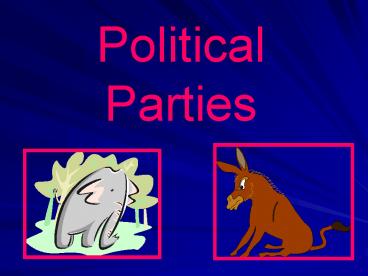Political Parties PowerPoint PPT Presentation
1 / 31
Title: Political Parties
1
Political Parties
2
- Political Party a group of people organized to
influence government through winning elections
and setting public policy.
3
I. Role of Political Parties
- Run Candidates for office.
- Inform voters of the issues.
- Organize the voters.
- Govern.
- Watchdog.
4
Running Candidates
- Nominating reduce choices to manageable level?
Primaries - Open and closed (CA is a closed primary State)
- Bonding Agent guarantee nominees arent
criminals and are capable of governing
5
Informing Voters
- Create Platforms (issues)
- Often created at national convention (esp. during
Presidential campaigns) or by party national
committee (DNC, RNC) - Campaigning
- Pamphlets, grassroots, speeches, photo-ops
- Fund raising
6
Organize Voters
- Party identification
- Registering to vote
- National, State, local organizations
7
The political party is organized from the bottom
up
National Party
State Party
Local Party
Grassroots Party in the Electorate
8
Party Structure
- 1. Party organization
- 2. Party in the electorate
- 3. Party in government
9
- Decentralized and based on federalism
- Presidents party tends to be better organized
and unified (bully pulpit) - National (DNC, RNC)
- National convention, national committee, national
chairperson, Congressional Campaign Committee
(DCCC, RCCC) - State and Local
- Set by State and local law/tradition
- Precinct and wards (ward boss)
10
Govern
- Government by party
- Negotiate, communicate between branches and
between national and State - Partisanship Bi-partisan
- Relatively weak compared to Europe
11
Watchdog
- Party in Power
- Party out of power
- Criticizes part in power in attempt to gain power
- Throw the rascals out!
- The Loyal Opposition
12
II. Political Party History in the USA . . .
13
The USA has had a two-party system throughout its
history third parties occasionally emerge, but
usually, most elected officials come from one of
the two major parties.
14
Reasons for Two-Party Dominance
- Historical basis
- Force of tradition
- Electoral system
- Single-member district
- Winner-take-all
- Election law 5 requirement, campaign finance
laws, primaries, getting on the ballot
15
Reasons for Two-Party Dominance
- American Ideological Consensus
- Pluralistic society
- Nation of immigrants
- Un-Americanism
16
The First Party System 1796 - 1828
Federalists Democratic-Republicans
17
Federalists
- Supported the Constitution.
- Supported the George Washington Administration as
led by Alexander Hamilton. - Favored Order over Liberty.
18
Democratic-Republicans
- Many had been Anti-Federalists, opponents of the
Constitution. - Symbolic leader Thomas Jefferson.
- Ironically, a major leader was James Madison.
Madison joined because he disliked the policies
of Hamilton. - Favored Liberty over Order
- Democrats are one of continuously running
political parties in the world
19
Legitimate Opposition
- Important point Both parties considered
political parties to be factions and wanted to
eliminate parties altogether. - The Democratic-Republicans, however, switched to
seeing their party as part of the legitimate
opposition (a group that keeps those in power
honest) and began to accept political parties as
a necessary evil.
20
Jacksonian Democrats Emerge 1828 - 1860
Democrats v. Whigs
21
Jackson and Van Buren
- The Democrats dominated politics by
- Building around populism of Jackson (war hero,
common man) - Advocating universal white male suffrage
- Establishing party institutions
- Party as positive good
22
After three consecutive presidents from the
Democratic-Republican Party, the Federalists
dissolved -- their successor was the Whig Party.
Meanwhile, under Andrew Jackson, the Democrats
(dropping the Republican name) continued in the
White House.
23
The Republican Era 1860 - 1932
Democrats v. Republicans
24
The Whigs divided over the issue of slavery a
third party, the Republicans, nominated Abraham
Lincoln, and he was elected President the Civil
War resulted . . .
25
- and with the defeat of the South the Republican
party dominated politics for almost 80 years. - The Radical Republicans pushed through Radical
Reconstruction (13, 14, 15 Amendments). - The Republican Party becomes the party of Civil
Rights until
26
The Compromise of 1877
- Weakened by the issue of continuing
Reconstruction in the South, the Republican
candidate Rutherford B. Hayes loses the popular
vote to Democrat Samuel Tilden but the electoral
vote was disputed (Florida) - Hayes makes a deal the Republicans will win the
election in return for removing Federal troops
from the South and ending Reconstruction.
27
Democratic Re-emergence 1932 - 1968
The New Deal Democrats
28
- New Deal Coalition urban workers, southern
whites, immigrants, Catholics, northern blacks - Truman (desegregation armed forces 1948)
Democrats party of civil rights
29
The Era of Divided Government 1968 - Present
Democrats v. Republicans
30
- Civil Rights Movement splinters New Deal
Coalition - Johnson 1964 Civil Rights Act we have lost the
South for a generation - Solid South switches to Republicans
- Vietnam further splinters Democrats? divided
government
31
Democrats tend to be liberal, while Republicans
tend to be conservative
Liberal favor the use of governmental power to
promote individual liberties and social progress.
Conservative favors the traditional the status
quo, and the idea that the government should stay
out of the affairs of its citizens.

